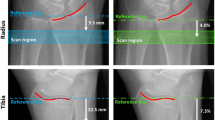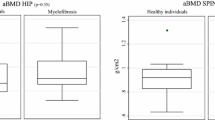Abstract
The use of micro-computed tomography (micro-CT) to study bone microstructure is continuously increasing. Thus, it is important to ensure that micro-CT can differentiate healthy and pathological bone. This study aimed to determine whether the reproducibility of bone histomorphometry and micro-CT, and agreement between the techniques, vary in bone samples with different metabolic status. Iliac crest biopsies (n = 36) were obtained from healthy subjects (n = 10) and from patients with osteoporosis (OP) (n = 15) or renal osteodystrophy (ROD) (n = 11). Micro-CT and histomorphometry analyses were repeated twice. Results were analyzed in separate groups and after pooling the data. Bone histomorphometry detected generally known differences between the diseases, whereas micro-CT did not detect differences between normal and ROD samples as effectively. Repeated measurements for BV/TV, Tb.Th, Tb.N, and Tb.Sp exhibited linear correlation coefficients (ρ) of 0.87–0.92 [coefficients of variations (CV), 8.3–27.2%] for histomorphometry and of 0.66–0.94 (CV, 4.4–23.4%) for micro-CT. There were no significant differences in reproducibility among samples from different study groups. Correlations between BV/TV (micro-CT) and mineralized bone volume (Md.V/TV, histomorphometry) were weaker than between BV/TV (micro-CT) and BV/TV (histomorphometry). When comparing the techniques, BV/TV, Tb.Th, and Tb.N displayed moderate correlations (ρ = 0.39–0.62, P < 0.05), and the agreement for BV/TV was highest in OP samples. The agreement between the techniques using clinical bone samples was moderate. Especially, micro-CT was less effective than bone histomorphometry in differentiating ROD from normal samples. The reproducibility was not affected by the health status of bone. Histomorphometry is still needed in clinical practice to study the remodeling balance in bone, and the methods are complementary.



Similar content being viewed by others
References
NIH Consensus Development Panel on Osteoporosis Prevention, Diagnosis, and Therapy (2001) Osteoporosis prevention, diagnosis, and therapy. JAMA 285(6):785–795
Parfitt AM, Mathews CH, Villanueva AR, Kleerekoper M, Frame B, Rao DS (1983) Relationships between surface, volume, and thickness of iliac trabecular bone in aging and in osteoporosis. Implications for the microanatomic and cellular mechanisms of bone loss. J Clin Invest 72:1396–1409
Muller R, Koller B, Hildebrand T, Laib A, Gianolini S, Ruegsegger P (1996) Resolution dependency of microstructural properties of cancellous bone based on three-dimensional mu-tomography. Technol Health Care 4:113–119
Recker R (2008) Bone biopsy and histomorphometry in clinical practice. In: Rosen C (ed) Primer on the metabolic bone diseases and disorders of mineral metabolism. The Sheridan Press, American Society for Bone and Mineral Research, Washington, DC, pp 180–187
Parisien MV, McMahon D, Pushparaj N, Dempster DW (1988) Trabecular architecture in iliac crest bone biopsies: infra-individual variability in structural parameters and changes with age. Bone (NY) 9:289–295
Podenphant J, Gotfredsen A, Nilas L, Norgard H, Braendstrup O, Christiansen C (1986) Iliac crest biopsy: an investigation on certain aspects of precision and accuracy. Bone Miner 1:279–287
Compston J (2004) Bone histomorphometry—the renaissance? Bonekey Osteovision 1:9–12
Muller R (2003) Bone microarchitecture assessment: current and future trends. Osteoporos Int 14:S89–S95 discussion S95–S99
Isaksson H, Töyräs J, Hakulinen M, Aula AS, Tamminen I, Julkunen P, Kröger H, Jurvelin JS (2010) Structural parameters of normal and osteoporotic human trabecular bone are affected differently by micro-CT image-resolution. Osteoporos Int. doi:10.1007/s00198-010-1219-0
Uchiyama T, Tanizawa T, Muramatsu H, Endo N, Takahashi HE, Hara T (1997) A morphometric comparison of trabecular structure of human ilium between microcomputed tomography and conventional histomorphometry. Calcif Tissue Int 61:493–498
Borah B, Dufresne TE, Chmielewski PA, Johnson TD, Chines A, Manhart MD (2004) Risedronate preserves bone architecture in postmenopausal women with osteoporosis as measured by three-dimensional microcomputed tomography. Bone (NY) 34:736–746
Recker R, Masarachia P, Santora A, Howard T, Chavassieux P, Arlot M, Rodan G, Wehren L, Kimmel D (2005) Trabecular bone microarchitecture after alendronate treatment of osteoporotic women. Curr Med Res Opin 21:185–194
Jiang Y, Zhao JJ, Mitlak BH, Wang O, Genant HK, Eriksen EF (2003) Recombinant human parathyroid hormone (1-34) [teriparatide] improves both cortical and cancellous bone structure. J Bone Miner Res 18:1932–1941
Dempster DW, Cosman F, Kurland ES, Zhou H, Nieves J, Woelfert L, Shane E, Plavetic K, Muller R, Bilezikian J, Lindsay R (2001) Effects of daily treatment with parathyroid hormone on bone microarchitecture and turnover in patients with osteoporosis: a paired biopsy study. J Bone Miner Res 16:1846–1853
Muller R, Van Campenhout H, Van Damme B, Van Der Perre G, Dequeker J, Hildebrand T, Ruegsegger P (1998) Morphometric analysis of human bone biopsies: a quantitative structural comparison of histological sections and micro-computed tomography. Bone (NY) 23:59–66
Campbell GM, Buie HR, Boyd SK (2008) Signs of irreversible architectural changes occur early in the development of experimental osteoporosis as assessed by in vivo micro-CT. Osteoporos Int 19:1409–1419
Chappard D, Retailleau-Gaborit N, Legrand E, Basle MF, Audran M (2005) Comparison insight bone measurements by histomorphometry and microCT. J Bone Miner Res 20:1177–1184
Thomsen JS, Laib A, Koller B, Prohaska S, Mosekilde L, Gowin W (2005) Stereological measures of trabecular bone structure: comparison of 3D micro computed tomography with 2D histological sections in human proximal tibial bone biopsies. J Microsc 218:171–179
de Vernejoul MC, Kuntz D, Miravet L, Goutallier D, Ryckewaert A (1981) Bone histomorphometric reproducibility in normal patients. Calcif Tissue Int 33:369–374
Chappard C, Marchadier A, Benhamou L (2008) Interindividual and intraspecimen variability of 3-D bone microarchitectural parameters in iliac crest biopsies imaged by conventional micro-computed tomography. J Bone Miner Metab 26:506–513
Ito M, Nakamura T, Matsumoto T, Tsurusaki K, Hayashi K (1998) Analysis of trabecular microarchitecture of human iliac bone using microcomputed tomography in patients with hip arthrosis with or without vertebral fracture. Bone (NY) 23:163–169
Waarsing JH, Day JS, Weinans H (2004) An improved segmentation method for in vivo microCT imaging. J Bone Miner Res 19:1640–1650
Parfitt AM, Drezner MK, Glorieux FH, Kanis JA, Malluche H, Meunier PJ, Ott SM, Recker RR (1987) Bone histomorphometry: standardization of nomenclature, symbols, and units. Report of the ASBMR Histomorphometry Nomenclature Committee. J Bone Miner Res 2:595–610
Gluer CC, Blake G, Lu Y, Blunt BA, Jergas M, Genant HK (1995) Accurate assessment of precision errors: how to measure the reproducibility of bone densitometry techniques. Osteoporos Int 5:262–270
Seeman E, Delmas PD (2006) Bone quality: the material and structural basis of bone strength and fragility. N Engl J Med 354:2250–2261
Perilli E, Baruffaldi F, Visentin M, Bordini B, Traina F, Cappello A, Viceconti M (2007) MicroCT examination of human bone specimens: effects of polymethylmethacrylate embedding on structural parameters. J Microsc 225:192–200
Acknowledgments
The authors acknowledge financial support from the National Graduate School of Musculoskeletal Disorders and Biomaterials, Finnish Cultural Foundation, Kuopio University Hospital, and the Academy of Finland (128863), as well as invaluable help with sample preparation from Ms. Aija Parkkinen.
Conflict of interest
None of the authors has any conflict of interest.
Author information
Authors and Affiliations
Corresponding author
About this article
Cite this article
Tamminen, I.S., Isaksson, H., Aula, A.S. et al. Reproducibility and agreement of micro-CT and histomorphometry in human trabecular bone with different metabolic status. J Bone Miner Metab 29, 442–448 (2011). https://doi.org/10.1007/s00774-010-0236-6
Received:
Accepted:
Published:
Issue Date:
DOI: https://doi.org/10.1007/s00774-010-0236-6




